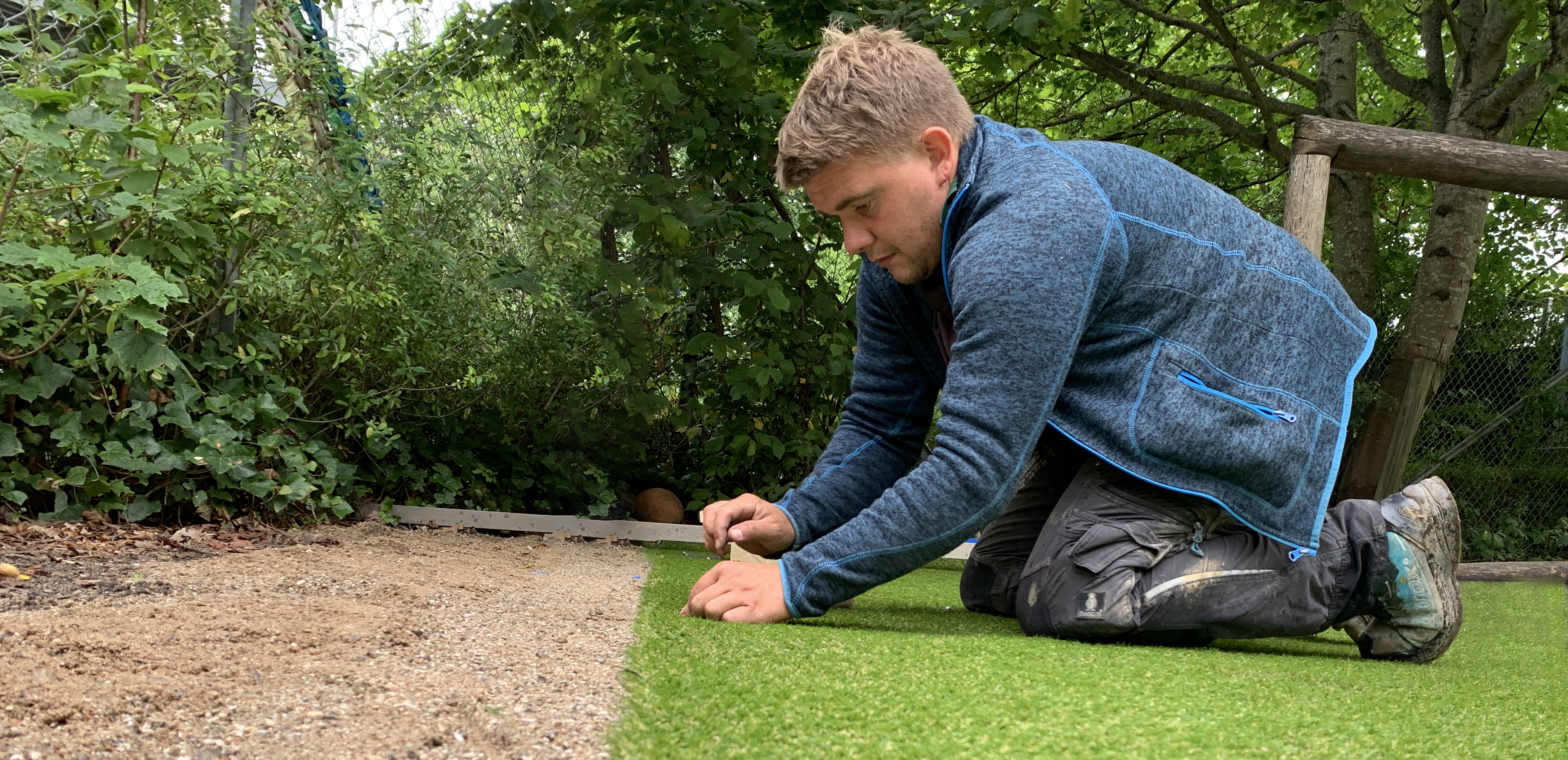What is hybrid grass?
Hybrid grass is the ideal choice if you want natural grass but still desire all the benefits of artificial turf. In simple terms, hybrid grass consists of a net of artificial grass with holes that allow natural grass to grow through. The hybrid grass strengthens and protects the natural grass, providing it with the best possible growth conditions. As a result, you have a consistently green and lush lawn without mud and bare patches. Hybrid grass is particularly suitable for areas where natural grass is subjected to heavy wear and tear over time. For instance, it is commonly used around playgrounds where children heavily use the grass during the summer months.
Here, Christian Svendsen from Safefloor provides more insights into hybrid grass.
How do you maintain artificial turf?
How to maintain your artificial turf
Regular maintenance of your artificial turf pays off, as proper care and routine upkeep can help extend its lifespan. This can save money and reduce environmental impact.
Remove weeds
Weeds can establish themselves, especially along the edges of the artificial turf. They are best removed by hand, but be careful when pulling out the roots to avoid damaging the underlying surface.
Remove moss, leaves, and debris
Clear away leaves, branches, and debris from the surface of the turf. Use a soft brush or a leaf blower to remove any leaves and debris that may get trapped in the fibers. If there are small shrubs or tree branches near the turf, it is advisable to trim them to reduce the amount of leaves and branches on the turf.
Infill sand
Most artificial turf installations incorporate infill sand within the turf. This provides several benefits, including improved stability of the grass and enhanced ball bounce during sports such as basketball and handball. Another important function of infill sand in artificial turf is to reduce wear and tear. Therefore, it is crucial to regularly replenish the sand as needed. Sand can dissipate from the turf due to shoe and boot contact, as well as heavy rainfall, making proper drainage essential.
Check drainage
Manholes and drainage pipes should be periodically cleaned (once every two years). It is recommended to hire a maintenance company to perform this task.
Monitor lines and seams
Artificial turf is often supplied in rolls with a width of 2 or 4 meters, so multiple sections are typically joined together to achieve the desired width. Similarly, the white lines are glued onto the turf. These seams should be regularly inspected, and if any loosening is detected, they should be repaired as soon as possible. A loose seam can quickly extend for several meters unless prompt action is taken.
Brush the artificial turf
Regular brushing of the artificial turf with a stiff brush helps maintain its appearance and structure. Brushing also helps lift the fibers and prevent them from being flattened. The surface should be brushed in alternating directions using a triangular/rectangular brush and/or rubber drag mat. It is recommended to avoid sharp turns or sudden stops when driving on the turf. This work is best done under dry conditions. If a tractor or similar vehicle is used, it should ensure that the wheel pressure is less than 0.75 kg/cm².
Vehicles on the artificial turf
No vehicles with narrow wheels or tires should drive on the artificial turf. All vehicles should be lightweight to avoid creating grooves on the surface or compressing the base. When performing maintenance with a vehicle, the operator should reduce speed during maneuvering and make wide turns to ensure that the wheels/tires do not leave tracks in the grass. It is suggested that all turning circles have a diameter of no less than 6 meters and no more than 10 meters. The wheel pressure MUST be less than 0.75 kg/cm².
Snow removal
The best method for removing snow from the surface of the field is to use a snow blower instead of brushing or plowing. A snow blower will clear the field without exerting pressure. Mechanical snow removal methods can potentially damage the fibers by pushing snow from the surface, which can also strain the field's seams. As a de-icing agent, road salt, Viaform, or Icebreaker can be used.
Avoid heat sources and open flames near the artificial turf
Artificial turf can be damaged by heat sources such as grills or similar items. Make sure to place these devices far enough away from the artificial turf to prevent any damage.
By following the above steps regularly, you can maintain your artificial turf in good condition for many years to come.
